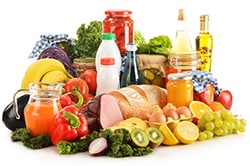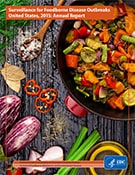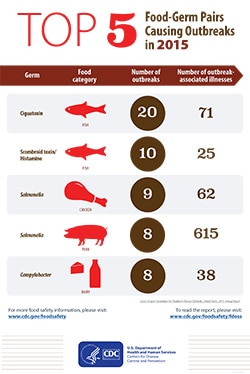Highlights from the 2015 Surveillance Report
When two or more people become ill from consuming the same contaminated food or drink, the event is called a foodborne disease outbreak. Outbreaks provide important insights into how germs are spread, which food and germ combinations make people sick, and how to prevent food poisoning. Each year, CDC summarizes foodborne disease outbreak data in an annual surveillance report and makes it available to the public through the NORS Dashboard.
Main Findings
In 2015, 902 foodborne disease outbreaks were reported, resulting in 15,202 illnesses, 950 hospitalizations, 15 deaths, and 20 food recalls.
- Single food categories associated with the most outbreak illnesses:
- Seeded vegetables, such as cucumbers or tomatoes (1,121 illnesses)
- Pork (924 illnesses)
- Vegetable row crops, such as leafy vegetables (383 illnesses)
- Single food categories associated with the most outbreaks:
- Fish (34 outbreaks)
- Chicken (22 outbreaks)
- Pork (19 outbreaks)
- Restaurants (469 outbreaks, 60% of outbreaks reporting a single location of preparation), specifically restaurants with sit-down dining (373, 48%), were the most commonly reported locations of food preparation.
- There were 30 multistate outbreaks, including the following types of foods linked to them:
- Vegetable row crops (4 outbreaks)
- Seeded vegetables (3 outbreaks)
- Grains, such as flour (2 outbreaks)
- Herbs (2 outbreaks)
- Mollusks (2 outbreaks)
Other Highlights
A single, confirmed pathogen caused 399 outbreaks. The most commonly reported were:
- Norovirus (145 outbreaks, 36% of the outbreaks)
- Salmonella (132 outbreaks, 33% of the outbreaks)
A single, confirmed pathogen caused 9,123 outbreak-related illnesses, 812 hospitalizations, and 15 deaths. The most common causes of outbreak-related illnesses were:
- Norovirus (3,794 illnesses, 42% of the illnesses)
- Salmonella (3,047 illnesses, 33% of the illnesses)
- Clostridium perfringens (512 illnesses, 6% of the illnesses)
The pathogens that caused the most outbreak-related hospitalizations were:
- Salmonella (456 hospitalizations, 56% of outbreak-related hospitalizations)
- Hepatitis A virus (141 hospitalizations, 17% of outbreak-related hospitalizations)
- Shiga toxin-producing Escherichia coli (98 hospitalizations, 12% of outbreak-related hospitalizations)
The pathogens that caused outbreak-related deaths were:
- Listeria monocytogenes (3 deaths)
- Salmonella (3 deaths)
- Shiga toxin-producing Escherichia coli (3 deaths)
- Clostridium botulinum (2 deaths)
- Hepatitis A virus (2 deaths)
- Clostridium perfringens (1 death)
- Staphylococcus aureus (1 death)
- Vibrio cholera (1 death)
For 40% of the outbreaks in 2015 (360 outbreaks), investigators were able to identify the food that made people ill. The food could be placed into a single category, out of 24 possible categories, in 194 of those outbreaks, or slightly more than half of them. The most commonly implicated food categories were:
- Fish (34 outbreaks, 18% of the outbreaks)
- Chicken (22 outbreaks, 11% of the outbreaks)
- Pork (19 outbreaks, 10% of the outbreaks)
- Dairy (18 outbreaks, 9% of the outbreaks)
- Pasteurization information was reported for 14 of the dairy outbreaks
- Thirteen of those outbreaks (93%) involved unpasteurized products
Outbreaks in which the food could be classified into a category included 4,364 illnesses. Outbreak-associated illnesses were most commonly from:
- Seeded vegetables, such as cucumbers or tomatoes (1,121 illnesses, 26% of the illnesses)
- Pork (924 illnesses, 21% of the illnesses)
- Vegetable row crops, such as leafy vegetables (383 illnesses, 9% of the illnesses)
- Chicken (333 illnesses, 8% of the illnesses)
Knowing which food and germ combinations make people sick is critically important to preventing future foodborne outbreaks. The confirmed germ-food pairs responsible for the most outbreak were:
-
Illnesses
- Salmonella in seeded vegetables (1,048 illnesses)
- Salmonella in pork (615 illnesses)
- Salmonella in vegetable row crops (263 illnesses)
-
Hospitalizations
- Salmonella in seeded vegetables (225 hospitalizations)
- Salmonella in pork (70 hospitalizations)
- Staphylococcus aureus enterotoxin in chicken (31 hospitalizations)
-
Deaths
- Salmonella in seeded vegetables (6 deaths)
- Clostridium botulinum in root and other underground vegetables (2 deaths)
- Clostridium perfringens in beef (1 death)
- Listeria monocytogenes in vegetable row crops (1 death)
- Salmonella in pork (1 death)
- Salmonella in sprouts (1 death)
- Vibrio vulnificus in mollusks (1 death)
The confirmed germ-food pairs responsible for the most outbreaks were:
- Ciguatoxin in fish (20 outbreaks)
- Scombroid toxin (histamine poisoning) in fish (10 outbreaks)
- Salmonella in chicken (9 outbreaks)
Among the 779 outbreaks and 12,054 illnesses with a reported single location where food was prepared, 469 outbreaks (60%) and 4,757 associated illnesses (39%) were attributed to foods prepared in a restaurant.
Among these outbreaks, sit-down dining restaurants were the type most commonly reported as the location where food was prepared (373 outbreaks, 48% of the outbreaks).
Product recalls occurred in 20 outbreaks:
- Chicken (2 outbreaks)
- Pork (2 outbreaks)
- Raw tuna (2 outbreaks)
- Alfalfa seeds and sprouts (1 outbreak)
- Apple cider (1 outbreak)
- Bread (1 outbreak)
- Celery (1 outbreak)
- Cucumber (1 outbreak)
- Drink mix (1 outbreak)
- Milkshakes (1 outbreak)
- Flour (1 outbreak)
- Ground beef (1 outbreak)
- Lettuce (1 outbreak)
- Moringa leaf powder (1 outbreak)
- Muffins (1 outbreak)
- Roast beef (1 outbreak)
- Sprouted nut butter (1 outbreak)
- Unpasteurized milk (1 outbreak)
In 2015, there were 30 multistate outbreaks (3% of all reported outbreaks), resulting in 1,947 illnesses (12% of illnesses), 411 hospitalizations (42% of hospitalizations), and 7 deaths (50% of deaths).
Germs responsible for multistate outbreaks:
- Salmonella (17 outbreaks)
- Shiga toxin-producing Escherichia coli (10 outbreaks)
- Cyclospora cayetanensis (1 outbreak)
- Listeria (1 outbreak)
- Vibrio parahaemolyticus (1 outbreak)
Foods implicated or suspected in multistate outbreaks of Salmonella:
- Tomatoes (2 outbreaks)
- Tuna sushi (1 confirmed, 1 suspected; 2 outbreaks total)
- Alfalfa seeds and sprouts (1 outbreak)
- Chicken (1 outbreak)
- Cucumber (1 outbreak)
- Latin-style soft cheese (suspected; 1 outbreak)
- Moringa leaf powder (1 outbreak)
- Pork (1 outbreak)
- Raw oysters (suspected; 1 outbreak)
- Raw tuna (1 outbreak)
- Sprouted nut butter (1 outbreak)
- Sushi (suspected; 1 outbreak)
- Truffle oil puree (1 outbreak)
- Unidentified food (1 outbreak)
Foods implicated or suspected in multistate outbreaks of Shiga toxin-producing Escherichia coli:
- Celery and onion (1 outbreak) (serogroup O157)
- Flour (1 outbreak) (serogroups O26 and O121)
- Pizza dough mix (suspected; 1 outbreak) (serogroup O157)
- Pre-packaged leafy greens (suspected; 1 outbreak) (serogroup O145)
- Pre-packaged salad (suspected; 1 outbreak) (serogroup O157)
- Romaine lettuce (suspected; 1 outbreak) (serogroup O157)
- Unidentified foods (serogroups O103 [2 outbreaks] and O26 [2 outbreaks])
Food implicated in a multistate outbreak of Cyclospora cayetanensis:
- Cilantro (1 outbreak)
Foods implicated in a multistate outbreak of Listeria:
- Lettuce (1 outbreak)
Foods implicated in a multistate outbreak of Vibrio parahaemolyticus:
- Raw oysters and clams (1 outbreak)
Four multistate outbreaks investigated in 2015 are not included in the 2015 tally because the first outbreak-associated illness occurred before 2015. Three were caused by Listeria; the implicated foods were ice cream (first illness in 2010), caramel apples (first illness in 2014), and cheese made with pasteurized milk (first illness in 2014). One was caused by Salmonella; the implicated food was cashews (first illness in 2014).
More Information
Learn More About Foodborne Outbreaks

- Full Surveillance Reports
- Foodborne Outbreak Online Database (FOOD): Individual outbreak data including etiology, locations, and food vehicles through current year
- Foodborne disease outbreak investigations and surveillance data from previous years
- CDC and the Food Safety Modernization Act
- The National Outbreak Reporting System (NORS): Resources on reporting foodborne disease outbreaks for state and local health departments:


